Page 80 of 394
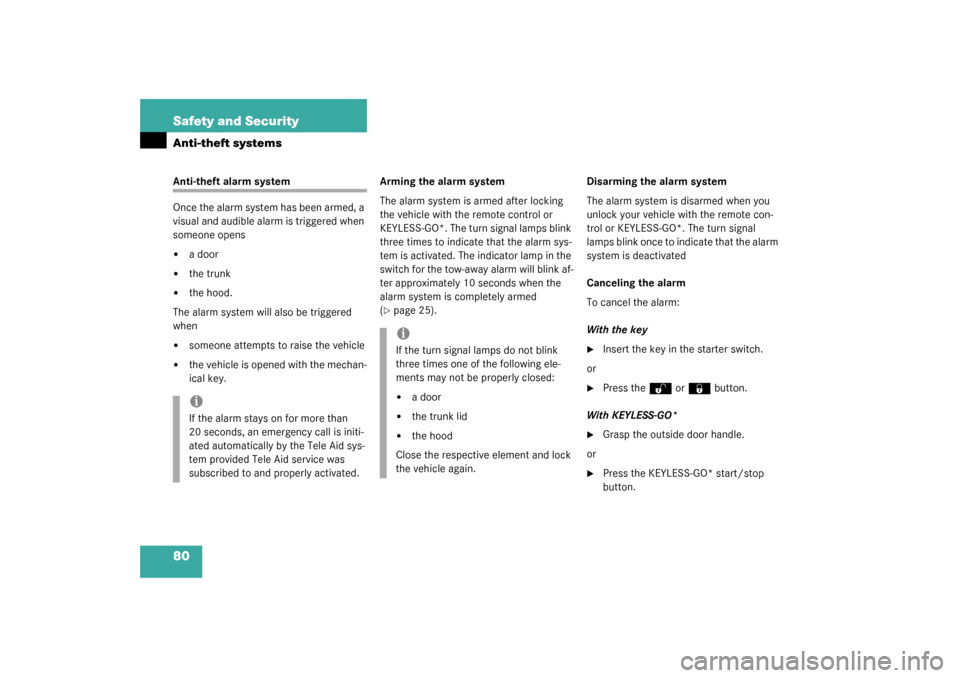
80 Safety and SecurityAnti-theft systemsAnti-theft alarm system
Once the alarm system has been armed, a
visual and audible alarm is triggered when
someone opens�
a door
�
the trunk
�
the hood.
The alarm system will also be triggered
when
�
someone attempts to raise the vehicle
�
the vehicle is opened with the mechan-
ical key.Arming the alarm system
The alarm system is armed after locking
the vehicle with the remote control or
KEYLESS-GO*. The turn signal lamps blink
three times to indicate that the alarm sys-
tem is activated. The indicator lamp in the
switch for the tow-away alarm will blink af-
ter approximately 10 seconds when the
alarm system is completely armed
(
�page 25).Disarming the alarm system
The alarm system is disarmed when you
unlock your vehicle with the remote con-
trol or KEYLESS-GO*. The turn signal
lamps blink once to indicate that the alarm
system is deactivated
Canceling the alarm
To cancel the alarm:
With the key
�
Insert the key in the starter switch.
or
�
Press the
Œ
or
‹
button.
With KEYLESS-GO*
�
Grasp the outside door handle.
or
�
Press the KEYLESS-GO* start/stop
button.
iIf the alarm stays on for more than
20 seconds, an emergency call is initi-
ated automatically by the Tele Aid sys-
tem provided Tele Aid service was
subscribed to and properly activated.
iIf the turn signal lamps do not blink
three times one of the following ele-
ments may not be properly closed:�
a door
�
the trunk lid
�
the hood
Close the respective element and lock
the vehicle again.
Page 112 of 394
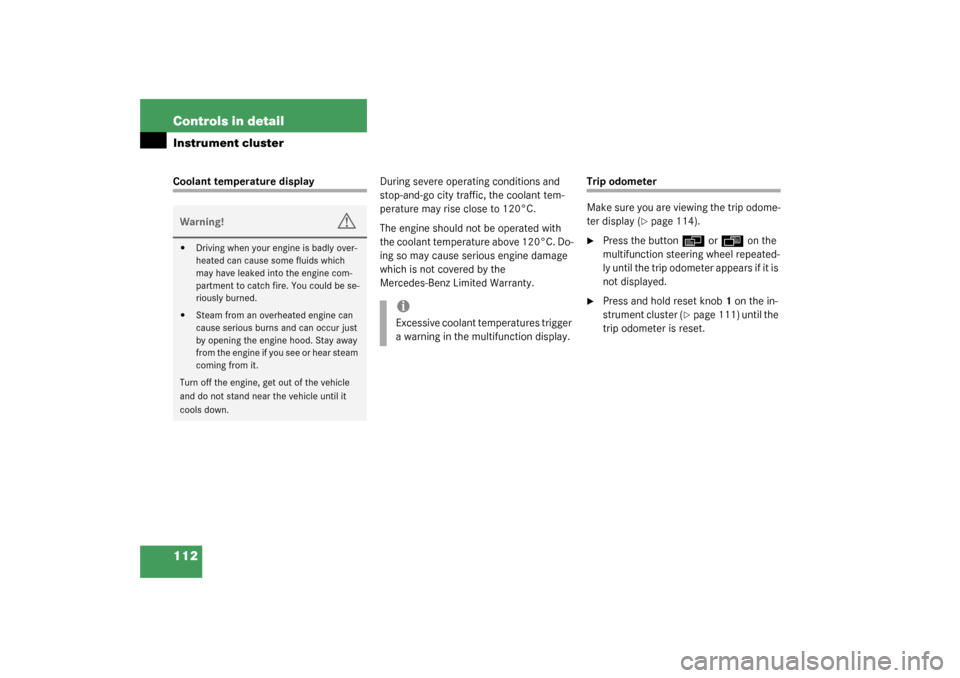
112 Controls in detailInstrument clusterCoolant temperature displayDuring severe operating conditions and
stop-and-go city traffic, the coolant tem-
perature may rise close to 120°C.
The engine should not be operated with
the coolant temperature above 120°C. Do-
ing so may cause serious engine damage
which is not covered by the
Mercedes-Benz Limited Warranty.
Trip odometer
Make sure you are viewing the trip odome-
ter display (
�page 114).
�
Press the button
è
or
ÿ
on the
multifunction steering wheel repeated-
ly until the trip odometer appears if it is
not displayed.
�
Press and hold reset knob1 on the in-
strument cluster (
�page 111) until the
trip odometer is reset.
Warning!
G
�
Driving when your engine is badly over-
heated can cause some fluids which
may have leaked into the engine com-
partment to catch fire. You could be se-
riously burned.
�
Steam from an overheated engine can
cause serious burns and can occur just
by opening the engine hood. Stay away
from the engine if you see or hear steam
coming from it.
Turn off the engine, get out of the vehicle
and do not stand near the vehicle until it
cools down.
iExcessive coolant temperatures trigger
a warning in the multifunction display.
Page 250 of 394
250 OperationDriving instructionsCoolant temperature
During severe operating conditions and
stop-and-go city traffic, the coolant tem-
perature may rise close to approx. 248°F
(120°C).
The engine should not be operated with
the coolant temperature over 248°F
(120°C). Doing so may cause serious en-
gine damage which is not covered by the
Mercedes-Benz Limited Warranty.
Warning!
G
�
Driving when your engine is badly over-
heated can cause some fluids, which
may have leaked into the engine com-
partment, to catch fire. You could be se-
riously burned.
�
Steam from an overheated engine can
cause serious burns and can occur just
by opening the engine hood. Stay away
from the engine if you see or hear steam
coming from it.
Turn off the engine, get out of the vehicle
and do not stand near the vehicle until it
cools down.
Page 252 of 394

252 OperationAt the gas station
Check regularly and before a long trip
1Coolant level
More information on coolant can be
found in the “Operation” section on
(
�page 256).
2Brake fluid (fuse box cover removed)
More information on brake fluid can be
found in the “Technical data” section
on (�page 353).
3Windshield washer and headlamp
cleaning system
More information on refilling the reser-
voir can be found in the “Operation”
section on (
�page 259).Engine oil level
More information on engine oil can be
found in the “Operation” section on
(
�page 254).
Vehicle lighting
Check function and cleanliness.More infor-
mation on replacing light bulbs can be
found in the “Practical hints” section on
(�page 316).
Tire inflation pressure
More information on tire inflate pressure
can be found in the “Operation” section on
(�page 262).
Opening hood see (
�page 253).
Removing fuse box cover see
(
�page 337).
Exterior lamp switch see (
�page 105)
iLeaving the engine running and the fuel
cap open can cause the
?
lamp to
illuminate.
More information can be found in the
“Practical hints” section (
�page 280).
Page 253 of 394
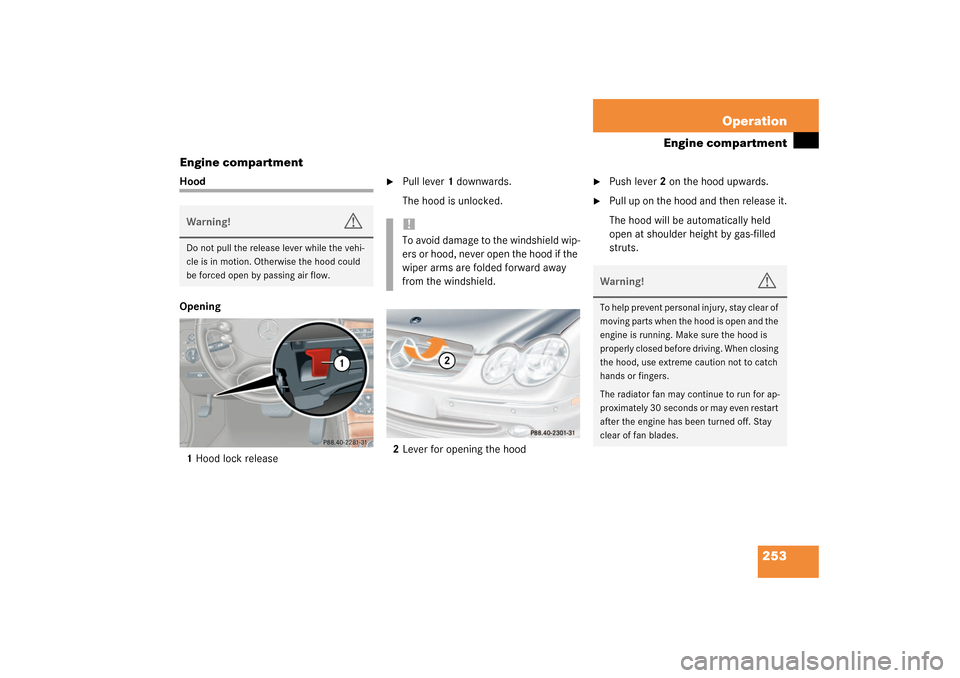
253 Operation
Engine compartment
Engine compartment
Hood
Opening
1Hood lock release
�
Pull lever 1 downwards.
The hood is unlocked.
2Lever for opening the hood
�
Push lever 2 on the hood upwards.
�
Pull up on the hood and then release it.
The hood will be automatically held
open at shoulder height by gas-filled
struts.
Warning!
G
Do not pull the release lever while the vehi-
cle is in motion. Otherwise the hood could
be forced open by passing air flow.
!To avoid damage to the windshield wip-
ers or hood, never open the hood if the
wiper arms are folded forward away
from the windshield.
Warning!
G
To help prevent personal injury, stay clear of
moving parts when the hood is open and the
engine is running. Make sure the hood is
properly closed before driving. When closing
the hood, use extreme caution not to catch
hands or fingers.
The radiator fan may continue to run for ap-
proximately 30 seconds or may even restart
after the engine has been turned off. Stay
clear of fan blades.
Page 254 of 394
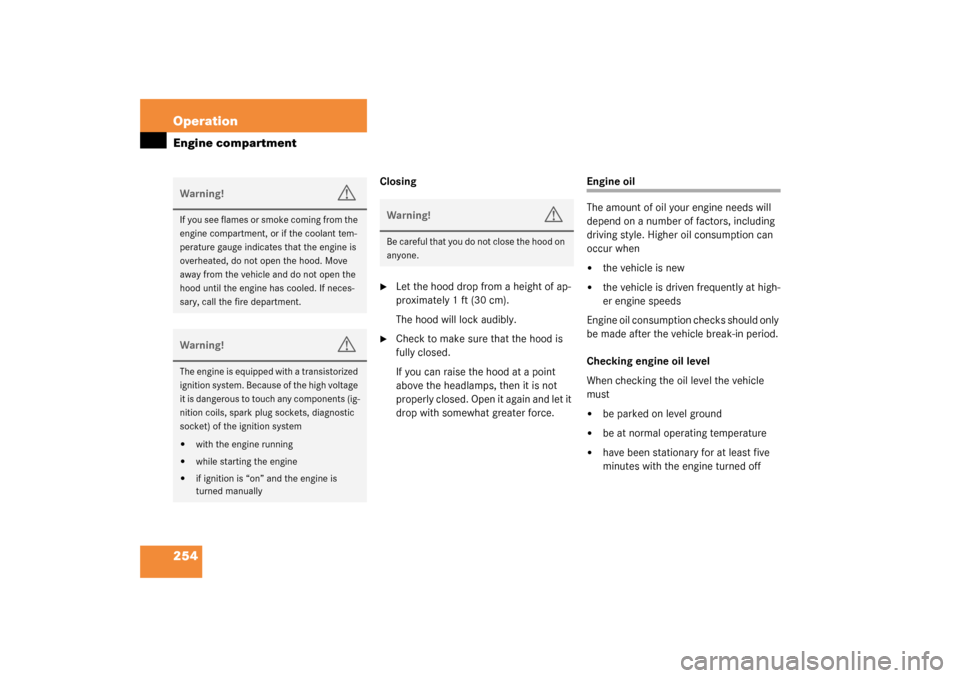
254 OperationEngine compartment
Closing�
Let the hood drop from a height of ap-
proximately 1 ft (30 cm).
The hood will lock audibly.
�
Check to make sure that the hood is
fully closed.
If you can raise the hood at a point
above the headlamps, then it is not
properly closed. Open it again and let it
drop with somewhat greater force.
Engine oil
The amount of oil your engine needs will
depend on a number of factors, including
driving style. Higher oil consumption can
occur when�
the vehicle is new
�
the vehicle is driven frequently at high-
er engine speeds
Engine oil consumption checks should only
be made after the vehicle break-in period.
Checking engine oil level
When checking the oil level the vehicle
must
�
be parked on level ground
�
be at normal operating temperature
�
have been stationary for at least five
minutes with the engine turned off
Warning!
G
If you see flames or smoke coming from the
engine compartment, or if the coolant tem-
perature gauge indicates that the engine is
overheated, do not open the hood. Move
away from the vehicle and do not open the
hood until the engine has cooled. If neces-
sary, call the fire department.Warning!
G
The engine is equipped with a transistorized
ignition system. Because of the high voltage
it is dangerous to touch any components (ig-
nition coils, spark plug sockets, diagnostic
socket) of the ignition system�
with the engine running
�
while starting the engine
�
if ignition is “on” and the engine is
turned manually
Warning!
G
Be careful that you do not close the hood on
anyone.
Page 257 of 394

257 Operation
Engine compartment
1Coolant expansion tank�
Using a rag, turn the cap slowly approx-
imately one half turn to the left to re-
lease any excess pressure.
�
Continue turning the cap to the left and
remove it.The coolant level is correct if the level
�
for cold coolant: reaches the black top
part of the reservoir
�
for warm coolant: is approx. 0.6 in
(1.5 cm) higher
�
Add coolant as required.
�
Replace and tighten cap.
More information on coolant can be found
in the “Technical data” section
(
�page 355).
Warning!
G
In order to avoid any possibly serious burns:�
Use extreme caution when opening the
hood if there are any signs of steam or
coolant leaking from the cooling system,
or if the coolant temperature gauge indi-
cates that the coolant is overheated.
�
Do not remove pressure cap on coolant
reservoir if engine temperature is above
194°F (90°C). Allow engine to cool
down before removing cap. The coolant
reservoir contains hot fluid and is under
pressure.
�
Using a rag, slowly open the cap approx-
imately
1⁄2 turn to relieve excess pres-
sure. If opened immediately, scalding
hot fluid and steam will be blown out un-
der pressure.
�
Do not spill antifreeze on hot engine
parts. Antifreeze contains ethylene gly-
col which may burn if it comes into con-
tact with hot engine parts.
Page 281 of 394
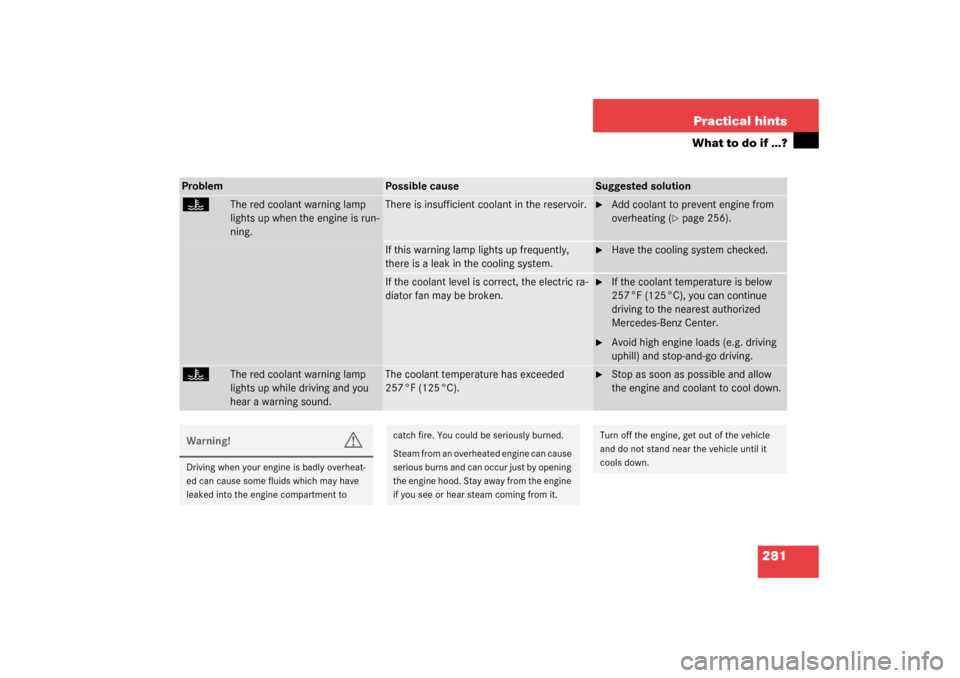
281 Practical hints
What to do if …?
Problem
Possible cause
Suggested solution
•
The red coolant warning lamp
lights up when the engine is run-
ning.
There is insufficient coolant in the reservoir.
�
Add coolant to prevent engine from
overheating (
�page 256).
If this warning lamp lights up frequently,
there is a leak in the cooling system.
�
Have the cooling system checked.
If the coolant level is correct, the electric ra-
diator fan may be broken.
�
If the coolant temperature is below
257 °F (125 °C), you can continue
driving to the nearest authorized
Mercedes-Benz Center.
�
Avoid high engine loads (e.g. driving
uphill) and stop-and-go driving.
•
The red coolant warning lamp
lights up while driving and you
hear a warning sound.
The coolant temperature has exceeded
257 °F (125 °C).
�
Stop as soon as possible and allow
the engine and coolant to cool down.
Warning!
G
Driving when your engine is badly overheat-
ed can cause some fluids which may have
leaked into the engine compartment to
catch fire. You could be seriously burned.
Steam from an overheated engine can cause
serious burns and can occur just by opening
the engine hood. Stay away from the engine
if you see or hear steam coming from it.
Turn off the engine, get out of the vehicle
and do not stand near the vehicle until it
cools down.